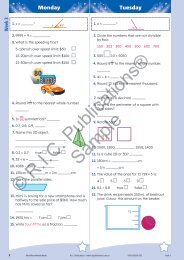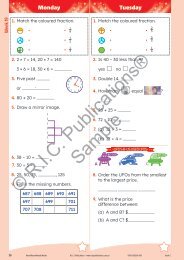PR-0552UK Primary Science - Book 2
You also want an ePaper? Increase the reach of your titles
YUMPU automatically turns print PDFs into web optimized ePapers that Google loves.
Shadow clock<br />
Light ~ Activity 3<br />
Objectives<br />
• recognise that light comes from<br />
different sources<br />
• recognise that light is needed in<br />
order to see<br />
Working scientifically<br />
• Questioning<br />
• Observing<br />
• Predicting<br />
• Investigating and experimenting<br />
• Estimating and measuring<br />
• Recording and communicating<br />
Designing and making<br />
• Exploring<br />
• Making<br />
• Evaluating<br />
Background information<br />
The position of the sun can be used<br />
to tell the time of day. Because the<br />
sun changes position, sundials only<br />
remain accurate in one position for<br />
about two weeks.<br />
A sundial is made of a dial plate<br />
marked out with hour lines and a<br />
raised section called a ‘gnomon’,<br />
that casts a shadow. The inclined<br />
edge of the gnomon is called the<br />
style and the shadow of this edge is<br />
used to tell the time.<br />
A sundial must be made specifically<br />
for the spot where it will be used and<br />
pointed in the right direction.<br />
Before sundials, the ancient<br />
Egyptians built tall stone towers<br />
called obelisks and could tell the<br />
time by looking at the shadow.<br />
Before the lesson<br />
Materials needed<br />
• Pictures of sundials, cardboard, pencils, modelling clay, markers, a compass<br />
(for direction).<br />
Preparation<br />
• Cut pieces of cardboard into rectangles 30 cm x 50 cm (one for each group).<br />
• Wait for a sunny day.<br />
The lesson<br />
Stimulus<br />
• Look at examples and pictures of sundials. Discuss the history of the sundial<br />
(refer to the background information).<br />
What to do<br />
• Divide pupils into small groups of three or four.<br />
• Pupils construct a shadow clock following directions set out on the<br />
worksheet.<br />
• Over the next few days, pupils test their shadow clocks to see how well they<br />
work. Pupils make suggestions on how they could improve their clocks.<br />
After the lesson<br />
Answers<br />
1. – 2. Teacher check<br />
3. Answers may include:<br />
Will not work if there is no sun.<br />
Are not precisely accurate.<br />
Will change as the Earth moves around the sun.<br />
Difficult to read inside.<br />
Additional activities<br />
• Research and make other types of sun clocks.<br />
Display ideas<br />
• Take photos of pupils at work and display on pin-up board. Pupils can summarise<br />
their results and display with the photographs.<br />
Viewing Sample<br />
42 <strong>PR</strong>IMARY SCIENCE ~ Prim-Ed Publishing ~ www.prim-ed.com


















